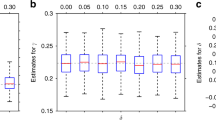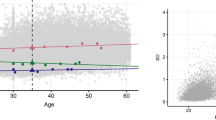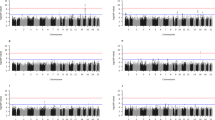Abstract
Background:
Obesity is rapidly becoming a global epidemic. Unlike many complex human diseases, obesity is defined not just by a single trait or phenotype, but jointly by measures of anthropometry and metabolic status.
Methods:
We applied maximum likelihood factor analysis to identify common latent factors underlying observed covariance in multiple obesity-related measures. Both the genetic components and the mode of inheritance of the common factors were evaluated. A total of 1775 participants from 590 families for whom measures on obesity-related traits were available were included in this study.
Results:
The average age of participants was 37 years, 39% of the participants were obese (body mass index ⩾30.0 kg/m2) and 26% were overweight (body mass index 25.0–29.9 kg/m2). Two latent common factors jointly accounting for over 99% of the correlations among obesity-related traits were identified. Complex segregation analysis of the age- and sex-adjusted latent factors provide evidence for a Mendelian mode of inheritance of major genetic effect with heritability estimates of 40.4 and 47.5% for the first and second factors, respectively.
Conclusions:
These findings provide a support for multivariate-based approach for investigating pleiotropic effects on obesity-related traits, which can be applied in both genetic linkage and association mapping.
This is a preview of subscription content, access via your institution
Access options
Subscribe to this journal
Receive 12 print issues and online access
$259.00 per year
only $21.58 per issue
Buy this article
- Purchase on Springer Link
- Instant access to full article PDF
Prices may be subject to local taxes which are calculated during checkout

Similar content being viewed by others
References
Obesity: preventing managing the global epidemic. Report of a WHO consultation. World Health Organization technical report series 2000; 894: i–xii, 1–253.
Caballero B . The global epidemic of obesity: an overview. Epidemiol Rev 2007; 29: 1–5.
Cheung BM, Thomas GN . The metabolic syndrome and vascular disease in Asia. Cardiovascular & Hematological Disorders Drug Targets 2007; 7: 79–85.
Horvath Z, Pankotai MG, Szabolcs I . Stakeholder appraisal of policy options for responding to obesity in Hungary. Obes Rev 2007; 8 (Suppl 2): 75–81.
Kruger HS, Puoane T, Senekal M, van der Merwe MT . Obesity in South Africa: challenges for government and health professionals. Public Health Nutr 2005; 8: 491–500.
Moon G, Quarendon G, Barnard S, Twigg L, Blyth B . Fat nation: Deciphering the distinctive geographies of obesity in England. Social Sci Med (1982) 2007; 65: 20–31.
Newell A, Zlot A, Silvey K, Arail K . Addressing the obesity epidemic: a genomics perspective. Prev chronic dis 2007; 4: A31.
Pender JR, Pories WJ . Epidemiology of obesity in the United States. Gastroenterol clin North Am 2005; 34: 1–7.
Urek R, Crncevic-Urek M, Cubrilo-Turek M . Obesity—a global public health problem). Acta Med Croatica 2007; 61: 161–164.
Wyatt SB, Winters KP, Dubbert PM . Overweight and obesity: prevalence, consequences, and causes of a growing public health problem. Am J Med Sci 2006; 331: 166–174.
Dina C, Meyre D, Gallina S, Durand E, Körner A, Jacobson P et al. Variation in FTO contributes to childhood obesity and severe adult obesity. Nat genet 2007; 39: 724–726.
Frayling TM, Timpson NJ, Weedon MN, Zeggini E, Freathy RM, Lindgren CM et al. A common variant in the FTO gene is associated with body mass index and predisposes to childhood and adult obesity. Science (New York, NY) 2007; 316: 889–894.
Herbert A, Gerry NP, McQueen MB, Heid IM, Pfeufer A, Illig T et al. A common genetic variant is associated with adult and childhood obesity. Science (New York, NY) 2006; 312: 279–283.
Lyon HN, Emilsson V, Hinney A, Heid IM, Lasky-Su J, Zhu X et al. The association of a SNP upstream of INSIG2 with body mass index is reproduced in several but not all cohorts. PLoS genet 2007; 3: e61.
Ginsburg E, Livshits G, Yakovenko K, Kobyliansky E . Major gene control of human body height, weight and BMI in five ethnically different populations. Ann hum genet 1998; 62: 307–322.
Zhao LJ, Xiao P, Liu YJ, Xiong DH, Shen H, Recker RR et al. A genome-wide linkage scan for quantitative trait loci underlying obesity related phenotypes in 434 Caucasian families. Hum genet 2007; 121: 145–148.
Wu X, Cooper RS, Borecki I, Hanis C, Bray M, Lewis CE et al. A combined analysis of genomewide linkage scans for body mass index from the National Heart, Lung, and Blood Institute Family Blood Pressure Program. Am J Hum Genet 2002; 70: 1247–1256.
Feitosa MF, Borecki IB, Rich SS, Arnett DK, Sholinsky P, Myers RH et al. Quantitative-trait loci influencing body-mass index reside on chromosomes 7 and 13: the National Heart, Lung, and Blood Institute Family Heart Study. Am J Hum Genet 2002; 70: 72–82.
Luke A, Wu X, Zhu X, Kan D, Su Y, Cooper R . Linkage for BMI at 3q27 region confirmed in an African-American population. Diabetes 2003; 52: 1284–1287.
Mukhopadhyay N, Finegold DN, Larson MG, Cupples LA, Myers RH, Weeks DE . A genome-wide scan for loci affecting normal adult height in the Framingham Heart Study. Hum hered 2003; 55: 191–201.
Wu X, Luke A, Cooper RS, Zhu X, Kan D, Tayo BO et al. A genome scan among Nigerians linking resting energy expenditure to chromosome 16. Obes res 2004; 12: 577–581.
Zhu X, Cooper RS, Luke A, Chen G, Wu X, Kan D et al. A genome-wide scan for obesity in African-Americans. Diabetes 2002; 51: 541–544.
Deng HW, Deng H, Liu YJ, Liu YZ, Xu FH, Shen H et al. A genomewide linkage scan for quantitative-trait loci for obesity phenotypes. Am J Hum Genet 2002; 70: 1138–1151.
Li X, Quinones MJ, Wang D, Bulnes-Enriquez I, Jimenez X, De La Rosa R et al. Genetic effects on obesity assessed by bivariate genome scan: the Mexican-American coronary artery disease study. Obesity (Silver Spring, Md 2006; 14: 1192–1200.
Livshits G, Otremski I, Kobyliansky E . Genetics of human body size and shape: complex segregation analysis. Am J Hum Biol 1995; 22: 13–27.
Livshits G, Roset A, Yakovenko K, Trofimov S, Kobyliansky E . Genetics of human body size and shape: body proportions and indices. Am J Hum Biol 2002; 29: 271–289.
Livshits G, Yakovenko K, Ginsburg E, Kobyliansky E . Genetics of human body size and shape: pleiotropic and independent genetic determinants of adiposity. Am J Hum Biol 1998; 25: 221–236.
Ataman SL, Cooper R, Rotimi C, McGee D, Osotimehin B, Kadiri S et al. Standardization of blood pressure measurement in an international comparative study. J Clin Epidemiol 1996; 49: 869–877.
Cooper R, Rotimi C, Ataman S, McGee D, Osotimehin B, Kadiri S et al. The prevalence of hypertension in seven populations of west African origin. Am J Public Health 1997; 87: 160–168.
Hicks C, Zhu X, Luke A, Kan D, Adeyemo A, Wu X et al. A genome-wide scan of loci linked to serum adiponectin in two populations of African descent. Obesity (Silver Spring, Md) 2007; 15: 1207–1214.
Luke A, Guo X, Adeyemo AA, Wilks R, Forrester T, Lowe Jr W et al. Heritability of obesity-related traits among Nigerians, Jamaicans and US black people. Int J Obes Relat Metab Disord 2001; 25: 1034–1041.
Luke A, Durazo-Arvizu R, Rotimi C, Prewitt TE, Forrester T, Wilks R et al. Relation between body mass index and body fat in black population samples from Nigeria, Jamaica, and the United States. Am J Epidemiol 1997; 145: 620–628.
Luke AH, Rotimi CN, Cooper RS, Long AE, Forrester TE, Wilks R et al. Leptin and body composition of Nigerians, Jamaicans, and US blacks. Am J Clin Nutr 1998; 67: 391–396.
Lukaski HC, Bolonchuk WW, Hall CB, Siders WA . Validation of tetrapolar bioelectrical impedance method to assess human body composition. J Appl Physiol 1986; 60: 1327–1332.
Wang Z, Deurenberg P, Wang W, Pietrobelli A, Baumgartner RN, Heymsfield SB . Hydration of fat-free body mass: review and critique of a classic body-composition constant. Am J Clin Nutr 1999; 69: 833–841.
Du Bois D, Du Bois EF . A formula to estimate the approximate surface area if height and weight be known 1916. Nutrition (Burbank, Los Angeles County, Calif) 1989; 5: 303–311; discussion 312–303.
Martin AD, Drinkwater DT, Clarys JP . Human body surface area: validation of formulae based on a cadaver study. Hum Biol 1984; 56: 475–488.
Mifflin MD, St Jeor ST, Hill LA, Scott BJ, Daugherty SA, Koh YO . A new predictive equation for resting energy expenditure in healthy individuals. Am J Clin Nutr 1990; 51: 241–247.
Bickel PJ, Doksum KA . Mathematical Statistics. Holden-Day: San Francisco, 1977.
Lawley DN, Maxwell AE . Factor Analysis as a Statistical Method. Macmillan Publishing Co. Inc.; New York, 1971.
Cerny BA, Kaiser HF . A Study of a Measure of Sampling Adequacy for Factor-Analytical Correlation Matrices. Multivariate Behav Res 1977; 12: 43–47.
Hasstedt SJ . jPAP: document-driven software for genetic analysis. Genet epidemiol 2005; 6: 255.
Wijsman EM . Monte Carlo Markov chain methods and model selection in genetic epidemiology. Comput Stat Data Anal 2000; 32: 349–360.
Grainger DJ, Heathcote K, Chiano M, Snieder H, Kemp PR, Metcalfe JC et al. Genetic control of the circulating concentration of transforming growth factor type beta1. Hum Mol Genet 1999; 8: 93–97.
Verloes A, Temple IK, Bonnet S, Bottani A . Coloboma, mental retardation, hypogonadism, and obesity: critical review of the so-called Biemond syndrome type 2, updated nosology, and delineation of three ‘new’ syndromes. Am J Med Genet 1997; 69: 370–379.
Blangero J, Konigsberg LW . Multivariate segregation analysis using the mixed model. Genet epidemiol 1991; 8: 299–316.
Goodman E, Dolan LM, Morrison JA, Daniels SR . Factor analysis of clustered cardiovascular risks in adolescence: obesity is the predominant correlate of risk among youth. Circulation 2005; 111: 1970–1977.
Xiao J, Wang X, Hu Z, Tang Z, Xu C . Multivariate segregation analysis for quantitative traits in line crosses. Heredity 2007; 98: 427–435.
Almasy L, Dyer TD, Blangero J . Bivariate quantitative trait linkage analysis: pleiotropy versus co-incident linkages. Genet epidemiol 1997; 14: 953–958.
Schmitz S, Cherny SS, Fulker DW . Increase in power through multivariate analyses. Behav Genet 1998; 28: 357–363.
Evans DM . The power of multivariate quantitative-trait loci linkage analysis is influenced by the correlation between variables. Am J Hum Genet 2002; 70: 1599–1602.
Amos C, de Andrade M, Zhu D . Comparison of multivariate tests for genetic linkage. Hum Hered 2001; 51: 133–144.
Ott J, Rabinowitz D . A principal-components approach based on heritability for combining phenotype information. Hum hered 1999; 49: 106–111.
Guttman L . Some necessary conditions for common factor analysis. Psychometrika 1954; XIX: 149–161.
Carttel RB . The Scree test for the number of factors. Multivariate Behav Res 1966; 1: 245–276.
Acknowledgements
This work was supported by The National Heart, Lung and Blood Institute (NHLBI) Grant number HL53353-10.
Author information
Authors and Affiliations
Corresponding author
Rights and permissions
About this article
Cite this article
Tayo, B., Harders, R., Luke, A. et al. Latent common genetic components of obesity traits. Int J Obes 32, 1799–1806 (2008). https://doi.org/10.1038/ijo.2008.194
Received:
Revised:
Accepted:
Published:
Issue Date:
DOI: https://doi.org/10.1038/ijo.2008.194
Keywords
This article is cited by
-
Assessing genetic and environmental influences on epicardial and abdominal adipose tissue quantities: a classical twin study
International Journal of Obesity (2018)
-
Using a Bayesian latent variable approach to detect pleiotropy in the Genetic Analysis Workshop 18 data
BMC Proceedings (2014)



